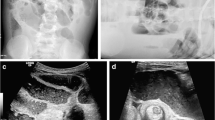Abstract
Purpose
This study aims to evaluate ultrasound findings that are predictive of the need for surgical management in pediatric patients with small bowel intussusceptions (SBIs).
Methods
A retrospective review of pediatric patients with SBIs treated from 2004 to 2009 was conducted. Patients were divided into surgical and non-surgical groups. Demographic data, ultrasound findings, treatments, and outcomes were collected and analyzed.
Results
There were 56 cases of SBIs in 31 males and 25 females ranging in age from 4 months to 9 years; 39 patients were managed conservatively and 17 patients underwent surgery. The mean length and diameter of the intussusception in the surgical group were 6.53 and 2.78 cm, respectively, and 3.21 and 1.81 cm, respectively in the non-surgical group (both, P < 0.001). Multivariate logistic regression analysis indicated that diameter, length, and thickness of the outer rim were independent predictors of surgery. Receiver operating characteristic curve analysis indicated an intussusception diameter ≥2.1 cm, length ≥4.2 cm, and thickness of the outer rim ≥0.40 cm were optimal cutoff values for predicting the need for surgery.
Conclusions
A diameter ≥2.1 cm, length ≥4.2 cm, and thickness of the outer rim ≥0.40 cm predict the need for surgical management in pediatric patients with SBIs.



Similar content being viewed by others
References
Munden MM, Bruzzi JF, Coley BD, Munden RF (2007) Sonography of pediatric small-bowel intussusception: differentiating surgical from nonsurgical cases. AJR Am J Roentgenol 188:275–279
Ko SF, Lee TY, Ng SH, Wan YL, Chen MC, Tiao MM, Liang CD, Shieh CS, Chuang JH (2002) Small bowel intussusception in symptomatic pediatric patients: experiences with 19 surgically proven cases. World J Surg 26:438–443
Koh EP, Chua JH, Chui CH, Jacobsen AS (2006) A report of 6 children with small bowel intussusception that required surgical intervention. J Pediatr Surg 41:817–820
Kim JH (2004) US features of transient small bowel intussusception in pediatric patients. Korean J Radiol 5:178–184
Park NH, Park SI, Park CS (2007) Ultrasonographic findings of small bowel intussusception, focusing on differentiation from ileocolic intussusception. Br J Radiol 80:798–802
Tiao MM, Wan YL, Ng SH, Ko SF, Lee TY, Chen MC, Shieh CS, Chuang JH (2001) Sonographic features of small-bowel intussusception in pediatric patients. Acad Emerg Med 8:368–373
Kornecki A, Daneman A, Navarro O, Connolly B, Manson D, Alton DJ (2000) Spontaneous reduction of intussusception: clinical spectrum, management and outcome. Pediatr Radiol 30:58–63
Doi O, Aoyama K, Hutson JM (2004) Twenty-one cases of small bowel intussusception: the pathophysiology of idiopathic intussusception and the concept of benign small bowel intussusception. Pediatr Surg Int 20:140–143
Sönmez K, Turkyilmaz Z, Demirogullari B, Karabulut R, Aral YZ, Konuş O, Başaklar AC, Kale N (2002) Conservative treatment for small intestinal intussusception associated with Henoch–Schönlein's purpura. Surg Today 32:1031–1034
Wiersma F, Allema JH, Holscher HC (2006) Ileoileal intussusception in children: ultrasonographic differentiation from ileocolic intussusception. Pediatr Radiol 36:1177–1181
Mateen MA, Saleem S, Rao PC, Gangadhar V, Reddy DN (2006) Transient small bowel intussusceptions: ultrasound findings and clinical significance. Abdom Imag 31:410–416
Strouse PJ, DiPietro MA, Saez F (2003) Transient small-bowel intussusception in children on CT. Pediatr Radiol 33:316–320
Navarro O, Dugougeat F, Kornecki A, Shuckett B, Alton DJ, Daneman A (2000) The impact of imaging in the management of intussusception owing to pathologic lead points in children. A review of 43 cases. Pediatr Radiol 30:594–603
Mirilas P, Koumanidou C, Vakaki M, Skandalakis P, Antypas S, Kakavakis K (2001) Sonographic features indicative of hydrostatic reducibility of intestinal intussusception in infancy and early childhood. Eur Radiol 11:2576–2580
Acknowledgments
This work was financially supported by Shengjing Outstanding Scientific Foundation (grant no. m850) from The Shengjing Hospital of China Medical University.
Conflicts of interest
None.
Author information
Authors and Affiliations
Corresponding author
Rights and permissions
About this article
Cite this article
Zhang, Y., Bai, YZ., Li, SX. et al. Sonographic findings predictive of the need for surgical management in pediatric patients with small bowel intussusceptions. Langenbecks Arch Surg 396, 1035–1040 (2011). https://doi.org/10.1007/s00423-011-0742-6
Received:
Accepted:
Published:
Issue Date:
DOI: https://doi.org/10.1007/s00423-011-0742-6




